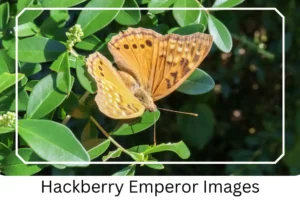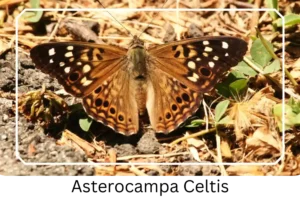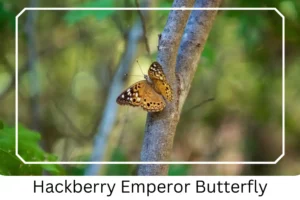Hackberry Emperor (Asterocampa celtis)
The Hackberry Emperor, a unique species within the North American butterfly fauna, is distinguished by its selective habitats and unconventional feeding habits. Predominantly found around water bodies, swamps, and urban parks, this butterfly exhibits behaviors and characteristics distinct from its floral-visiting counterparts. This piece aims to delve into the life cycle, identification features, and fascinating behaviors of the Hackberry Emperor, providing enthusiasts and scholars alike with comprehensive insights.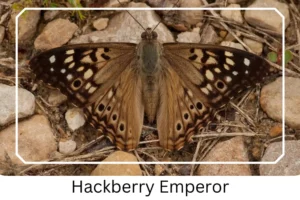
Scientific Classification
- Family: Nymphalidae
- Genus: Asterocampa
- Common names: Hackberry Butterfly
- Scientific Name: Asterocampa celtis
Overview
The Hackberry Emperor butterfly, not commonly seen frequenting flowers like its counterparts, prefers the foliage of hackberry trees for sustenance. This butterfly’s lifecycle—from a distinctly horned caterpillar to a fast-flying adult—showcases a remarkable adaptation to its environment. Through each stage of its life, the Hackberry Emperor exhibits characteristics that are both intriguing and vital for its survival. Understanding these phases not only enlightens us about the species itself but also about the broader ecological web it inhabits.
Description and Identification
Caterpillar
The larval stage of the Hackberry Emperor is notable for its bright green body, approximately 1.4 inches in length, adorned with pale yellow bumps and brown-black dorsal projections resembling horns. Sharp tail-like protrusions mark its rear, preparing it for hibernation in forest floors during winter, only to emerge in spring to feed on hackberry foliage.
Pupa
Transformation into adulthood begins in the chrysalis phase, where the pupa displays a dark green hue with white spots and diagonal white lines across the abdomen. Secured under hackberry leaves, it emerges as an adult butterfly in early summer.
Adult Butterfly
Sexual Dimorphism: This species shows no significant sexual dimorphism, making it challenging to distinguish between males and females based on appearance alone.
Color and Appearance: Adult Hackberry Emperors vary in color from tan to reddish-brown, with distinctive patterns on their wings that change with geographical location. A single eyespot on the forewings and a series of white spots and black bars characterize their wings when open.
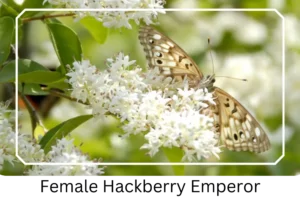
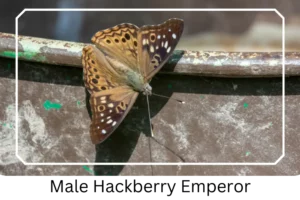
Average Wingspan: Ranges between 1.38 – 2.48 inches (3.5 – 6.3 cm).
Flight Pattern: Fast and erratic
Eggs
The eggs are white to gray, laid in clusters on the underside of hackberry leaves, ensuring the next generation’s survival.
Quick Facts | |
| Distribution | Predominantly found throughout the southeastern United States. |
| Habitat | Favors wooded roadsides, streams, towns, and the edges of forests and rivers. |
| Lifespan of Adults | Lives for 6 to 14 days. |
| Host Plants | Primarily feeds on hackberry leaves and buds. |
| Adult Diet | Includes hackberry flower nectar, sap, feces, decaying animals, and old fruit. |
How to Identify Hackberry Emperor?
Identifying the Hackberry Emperor butterfly can be an enriching experience, thanks to its distinct features. Look for a medium-sized butterfly with a wingspan ranging from 1.38 to 2.48 inches. The adults exhibit a tan to reddish-brown coloration when their wings are open, showcasing a unique pattern of eyespots, white jaggy spots, and black bars across the forewings. The erratic and fast flight pattern of these butterflies, combined with their preference for hackberry trees, makes them stand out in their natural habitat. Observing these characteristics, along with their unusual habit of not visiting flowers commonly, can help enthusiasts and researchers alike in accurately identifying the Hackberry Emperor in the wild.
Did You Know?
- Unlike many butterflies, the Hackberry Emperor does not use its feet and antennae to touch flowers when feeding on nectar, relying solely on its proboscis. This behavior indicates their limited role in pollination.
- These butterflies have been known to land on humans, licking off sweat to ingest sodium, a behavior not commonly observed in other butterfly species.
- The Hackberry Emperor’s choice of decaying matter and feces as food sources highlights their role in nutrient recycling within their ecosystems.
Conclusion
The Hackberry Emperor butterfly serves as a fascinating subject for study and observation, showcasing unique behaviors and adaptations that set it apart from other species. From its larval stage, adorned with horn-like projections, to its fast and erratic flight as an adult, each phase of its life cycle offers insights into the complexity of nature. By understanding the nuances of its existence, we not only gain knowledge about the Hackberry Emperor itself but also about the broader ecological interactions it participates in.
Hackberry Emperor Pictures

Scientific Classification

- Family: Nymphalidae
- Genus: Asterocampa
- Common names: Hackberry Butterfly
- Scientific Name: Asterocampa celtis

